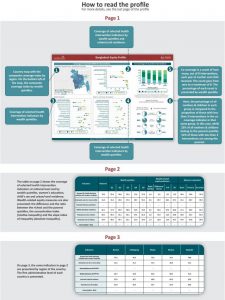
Image credit: Countdown to 2030.
Originally published on Countdown to 2030 website – Country profile webinar announcement.
Countdown to 2030 for Women’s Children’s and Adolescent’s Health and partner organizations published new and updated country profiles for:
- Reproductive, maternal, newborn child and adolescent health (RMNCAH) and nutrition
- Equity
- Early childhood development
The profiles were first shared during a webinar on December 14, 2021, in collaboration with the Partnership for Maternal, Newborn and Child Health. [See webinar recording here.]
This year the RMNCAH and nutrition country profiles include new indicators, larger graphics, and a more interactive format using Tableau software, which includes opportunities for user feedback and accessible links to explain indicator definitions and data sources. As in previous years, the 137 profiles of low and middle income countries has been reviewed and approved by experts in each country. UNICEF and the University of North Carolina – Chapel Hill and North Carolina State University played a major role in producing the profiles on behalf of Countdown.
The equity profiles are drawn from mega database of 118 low- and middle-income countries and more than 412 national surveys, mainly Demographic Health Surveys and Multiple Indicator Cluster surveys and are produced by the International Center for Equity in Health at Pelotas University, Brazil, a core Countdown partner. The profiles include 13 indicators across the continuum of care, plus a composite coverage index, which is available for subnational regions.
The early childhood development profiles were first published in 2018 for 91 countries. They now include 197 countries, including 63 high-income countries, and 24 indicators, based on the nurturing care framework which includes the domains of good health, adequate nutrition, security & safety, early learning and responsive caregiving. UNICEF and the Countdown working group on early childhood development are the lead contributors.
The data sources are an important advocacy tool, said Helga Fogstad, executive director of the Partnership for Maternal, Newborn and Child Health, during the December 14 launch webinar for the 2021 country profiles. “We are looking at ways of how to use these profiles and expose them to the right target audience at the right time.”
The first Countdown country profiles were published 15 years ago to track progress toward the Millennium Development Goals and were focused on child survival. These country profiles represented one of the first global efforts to systematically synthesize the information available to guide programs. Since then, the profiles have gradually expanded to cover the continuum of care for RMNCAH and nutrition.
Countdown profiles contribute to monitoring the Global Strategy for Women’s, Children’s and Adolescents’ Health (2016-2030), which was developed in response to the Sustainable Development Goals. WHO maintains a dashboard to monitor the 60 indicators of the strategy.
Country profiles are widely used by many audiences for various purposes. For example, civil society organizations may use them as an accountability tool; country governments may use the data for planning and priority settings; and academic and research partners may analyze them to assess trends over time.
“This consolidation of highly synthesized data offers a very good opportunity for countries like Kenya to access data in one platform,” said Helen Kairie, head of the monitoring and evaluation division at the Kenya Mistry of Health, during the launch webinar. She noted that the RMNCAH and nutrition profile can be used for both planning and review processes, that it is helpful for understanding subnational variations, and that the variety of indicators included adds to its usefulness.